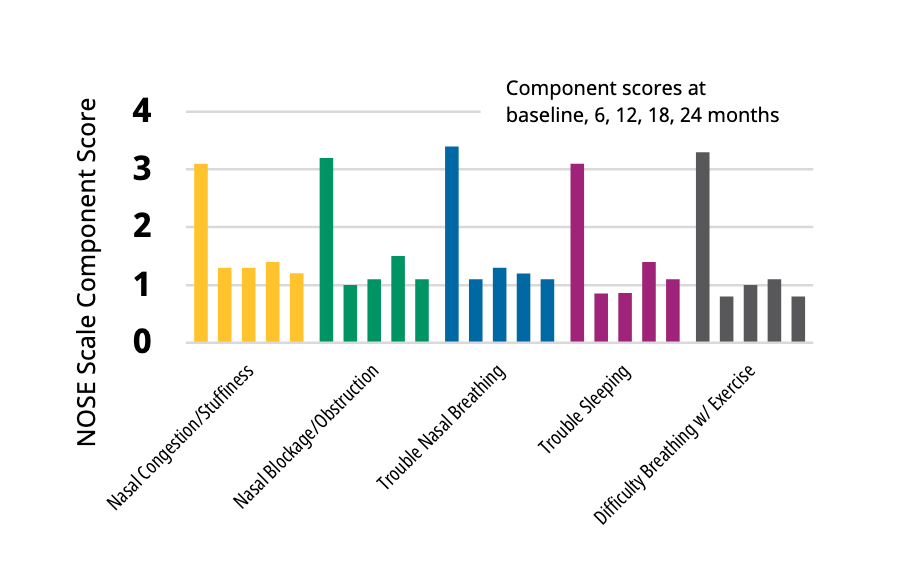Introduction
Chronic nasal obstruction contributes to a decreased quality of life. Nasal valve dysfunction is increasingly recognized as a cause of nasal obstruction. The internal nasal valve – the area between the cartilaginous septum, the caudal end of the upper lateral cartilage, and the circumferential neighboring structures, such as the inferior turbinates – is the area of the nasal airway with the greatest resistance to airflow.

Patients report significantly better sleep function and better psychologic function (e.g., concentration, productivity, and decreased feelings of frustration) after correction of their nasal obstruction.
In-office temperature-controlled radiofrequency (RF) treatment of nasal valve obstruction using the Aerin Medical VivAer® Stylus previously demonstrated a 69% decrease in Nasal Obstruction Symptom Evaluation (NOSE) Scale scores at 6 months postprocedure.
NOSE Scale scores and quality of life metrics were collected on a total of 36 participants through 2 years postprocedure in an extension of the single arm, multicenter, prospective study.
Results and Conclusion
Mean NOSE Scale scores decreased from 80.8 at baseline to 24.9 at 6 months postprocedure. The mean NOSE Scale score was 26.5, a 66.5% improvement over baseline, at 2 years postprocedure. All NOSE Scale component scores followed a similar trend. 97.2% of participants had ≥15-point improvement over baseline at 2 years. Improvement of at least one severity category was found in ≥75% of participants at all follow-up time points.


Fewer participants had nasal obstruction categorized as severe or extreme at 2 years. Fewer participants reported fairly bad or severe symptoms in each NOSE Scale component score at 2 years. The results of a quality of life questionnaire revealed better sleep function and increased sense of wellbeing, along with decreased use of oral medication, nasal sprays, and nasal breathing strips.
| Less difficulty falling asleep | 78% |
| Less waking at night | 69% |
| Better sleep throughout the night | 72% |
| Wake feeling rested | 61% |
| Less fatigue during the day | 53% |
| Increased sense of overall well-being | 64% |
| Decreased use of oral medications | 67% |
| Decreased use of nasal sprays | 64% |
| Decreased use of nasal breathing strips | 81% |
| 2 years |
In-office bipolar temperature-controlled RF treatment of nasal valve obstruction using the Aerin Medical VivAer Stylus is safe and is associated with a durable improvement in the symptoms of nasal obstruction and durable improvement in nasal obstruction-related quality of life through 2 years postprocedure.
Moshe Ephrat, MD , Ofer Jacobowitz, MD, PhD and Mark Driver, MD. Quality‐of‐life impact after in‐office treatment of nasal valve obstruction with a radiofrequency device: 2‐year results from a multicenter, prospective clinical trial. Int Forum Allergy Rhinol. https://doi.org/10.1002/alr.22667
Aerin Medical Contact
Email: customerservice@aerinmedical.com
Call: 833-4-VIVAER (833-484-8237)
Or submit your inquiry below and we’ll get back you within one business day.